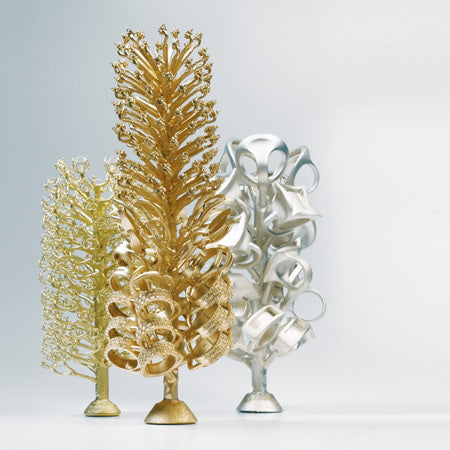What does “recycled metal” really mean? What we do and don’t do when it comes to recycling

This blog entry is prompted by a couple of recent questions about working with recycled metals. Etsy now offers a new category – “recycled” – that I can click on before I publish my listing. And since the metals I cast in are recycled, I click “yes”. And now that this category is visible to clients, they want to know what it means. Of course the word “recycled” can be used to describe a variety of processes. An item might be partially recycled or entirely recycled: printing paper, for instance, can be fully made from recycled paper, partly made from recycled paper, or not at all. Items can be made “with” recycled materials or entirely “from” recycled materials. With many products it is hard to know which the case is. For example, my local ice cream shop (Milk Sugar Love) makes ice cream with but not entirely from organic ingredients. The ice cream base is organic, but non-organic ingredients are sometimes used to make different flavors. Cecile Raley Designs works with a similar principle. Our basic metals are recycled, the rest of the “ingredients”

First let me talk about what is not recycled in our shop: we do not use recycled gemstones. Many pre-used gems have scratches or cracks and can’t be re-purposed. Secondly, it is hard to determine origin and treatment for many gems, so we prefer to work with vendors whose product we can. There are jewelers that specialize in using “breakout” gems but they are usually “brick and mortar” places where the jeweler can take a quick look at the used jewelry and determine if it’s worth reusing the gem. And if the jeweler isn’t primarily in the business of selling gems, they are not necessarily obliged to try to determine its origin or treatment. They just reuse them if the customer wants them to and if it is not liable to break.
What we also don’t do is use the metal a customer supplies to us – this is because we don’t cast here at the office. It is both too dangerous and requires extensive equipment and expertise, so, like most jewelers or jewelry designers, we outsource. We are, however, able and willing to collect metal and sell it on behalf of the customer at 98.5% of the daily spot market. We don’t return cash but we can put it towards a custom (or other) order.
However, if a customer wishes to use their own gold for sentimental reasons, our casting service can make a “tree” just for the piece they are casting for that particular client. The fee for that is $150 (that's their fee, not mine, no markup). So I suggest doing this only if using their own metal is particularly important to someone.

In short, for Cecile Raley Designs, “recycled” means something fairly simple: the casting service we use – Taba Casting - works with recycled and ethically sourced metals. That means they don’t use “only” recycled but they use them whenever they can. Recycled metals are collected by refineries on the open market and cleaned from impurities in the refining process. For more information about our casting house, go here: http://tabacast.com/
Our findings are largely not recycled, or rather; they don't come from companies that make the use of recycled metals their priority. All of the findings will contain some recycled metals nonetheless.
In closing, I would be remiss not to mention a small but promising new industry: fair trade or fair mined gold. Fair mined gold adopts the fair trade standard and is based on the idea of supporting small scale mining in an environmentally friendly way around the world. The aim is to support artisanal mining in countries where exploitation of miners is common, i.e. Tanzania, Kenya, Uganda and other places. You can find more information about fair mined gold and silver and their processes on this website: http://www.fairgold.org/

Stay tuned.
